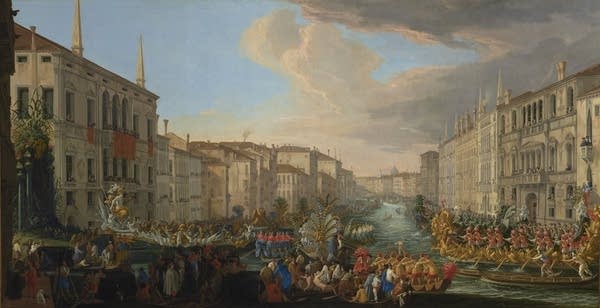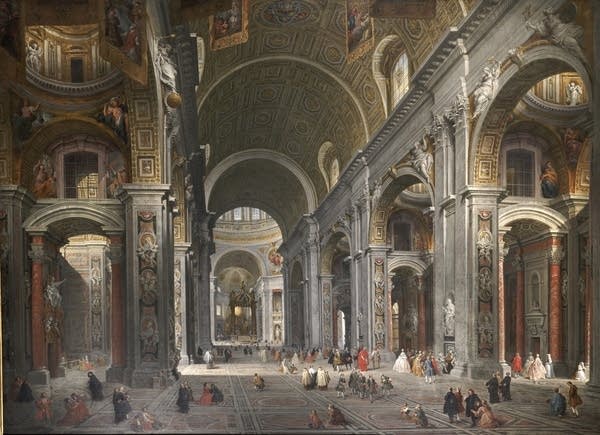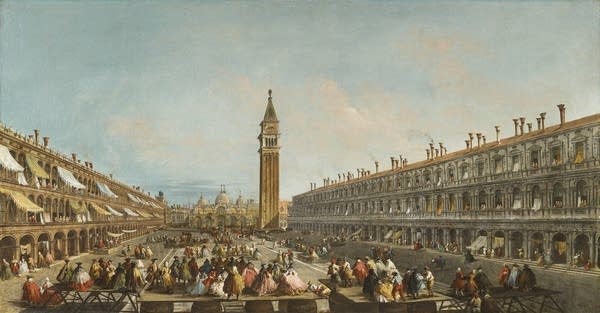When current events were captured in paintings

Go Deeper.
Create an account or log in to save stories.
Like this?
Thanks for liking this story! We have added it to a list of your favorite stories.
As we have learned from talk about "fake news," the definition of what is news — and even history — is often open to interpretation. A new show at the Minneapolis Institute of Art examines what was news in 18th century Europe.
The show is called "Eyewitness Views."
Just as today, when you hosted a big bash or got some big award in the 18th century, you often wanted a picture. Of course, it was a little more complicated back then than whipping out your smartphone. You would want it done in oil by the best painter possible. You'd want it to have a little zip, or at least what passed as zip in the 1750s. And you'd want it for your home, or the home of someone you wanted to impress.
"These were all for personal consumption," said Patrick Noon, Mia's chair of paintings. "And they are great propaganda for whoever commissioned these paintings. 'Look at all these people who showed up for my event!'"
Turn Up Your Support
MPR News helps you turn down the noise and build shared understanding. Turn up your support for this public resource and keep trusted journalism accessible to all.

Noon stood in the middle of a gallery surrounded by large, sumptuous depictions of gatherings and presentations of decrees, with a couple of natural disasters thrown in for good measure. Most were made to dominate a room. Some were painted for palaces.
"These are historical events that ... may have no relevance today, but they did at the time," said Noon.
Some of the events, such as the arrival in Rome of the French Duke de Choiseul to present his credentials as an ambassador to the pope in 1754, merited several images. The paintings are very large. It's easy to spot the duke as the most brightly dressed person in the picture, but it's striking how he is just one of hundreds of quite small figures all over the canvas. Noon said that was deliberate.
"The point was to show as many people as you possibly could, but also of every class," he said. "The crowd was YUGE!" he continued, laughing. "But the idea was to get as many people into these pictures as possible, because ... like the architectural setting itself, it adds a certain amount of gravitas to the whole thing. 'Oh yeah, this is really important.'"
Many of the pictures are of scenes in Rome; even more are of Venice. It's a feast for the eyes. But Noon pointed out that, quite often, what the artist painted was not the actual event.

In Venice, it was expected that a new ambassador would arrive in a fleet of sumptuous barges specially built for the occasion. Not only did that take an enormous amount of money, it also took time. So what would happen, Noon said, was that an ambassador would arrive and quickly present his credentials to the doge.
"And then they would go out and they'd start spending huge amounts of money to get this kind of event staged, and they would re-stage this event that was very important for them, and then they would have these artists paint these events," he said.
Sometimes, depending on the circumstances, the painter might not even see the re-staging, and would have to imagine the event. Even when the artist was there, it was also fair game to make things look even more spectacular than they were in real life. Some artists added entire floors to buildings, or painted interior scenes from a perspective that could only have been gained from outside a building, through some sort of X-ray vision.
Noon said while most of these paintings depict events that have no real bearing on our lives today, they do represent a significant time. There's a picture of a balloon flight witnessed by Benjamin Franklin during his time in Paris. These pictures are packed with information.
"You can look at this from any different perspective," he said. "Including the history of costume, the history of culture, the history of painting. There is so much visual material in here to digest, but it's a fun thing to do."
And if you want the history, it's explained on the wall, and even more extensively in a show catalogue. It's huge.



